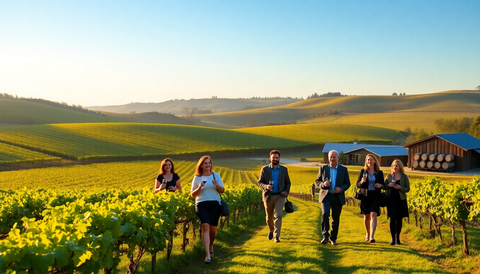As you step into the world of wine, the sheer variety of styles and grape varieties can be both exciting and overwhelming. Whether you're a seasoned wine enthusiast or just starting your journey, understanding the different wine types and their characteristics is the key to unlocking a world of flavors and discovering your personal preferences.
In this comprehensive guide, we'll explore the diverse landscape of wine, from the bold and full-bodied reds to the crisp and refreshing whites, and everything in between. Join us as we delve into the nuances of each wine style, uncovering the unique aromas, flavors, and food pairings that make each one a true delight.
The Basics of Wine Styles
At the heart of the wine world lies a fundamental distinction: the division between red, white, and rosé wines. Each of these broad categories encompasses a range of styles, each with its own distinct personality and characteristics.
Red Wines
Red wines are characterized by their deep, rich hues, ranging from vibrant ruby to inky purple. These wines are typically made from red grape varieties, such as Cabernet Sauvignon, Merlot, Pinot Noir, and Shiraz (also known as Syrah). Red wines are known for their bold, full-bodied flavors, often featuring notes of ripe berries, spices, and sometimes even hints of oak.
One of the key factors that influence the style of a red wine is the level of tannins. Tannins are naturally occurring compounds found in the skins, seeds, and stems of grapes, and they contribute to the wine's structure, mouthfeel, and aging potential. Wines with higher tannin levels, such as Cabernet Sauvignon and Nebbiolo, are often described as more "tannic" and can benefit from aging, as the tannins soften over time.
White Wines
In contrast to their red counterparts, white wines are typically lighter in color, ranging from pale straw to golden hues. These wines are made from white grape varieties, such as Chardonnay, Sauvignon Blanc, Riesling, and Pinot Grigio. White wines are often characterized by their refreshing acidity, which can range from crisp and zesty to rich and creamy, depending on the grape variety and winemaking techniques.
One of the key factors that influence the style of a white wine is the level of oak aging. Some white wines, like Chardonnay, are often aged in oak barrels, which can impart flavors of vanilla, spice, and a creamy mouthfeel. Other white wines, such as Sauvignon Blanc and Pinot Grigio, are typically fermented and aged in stainless steel tanks, preserving their bright, fruit-forward characteristics.
Rosé Wines
Rosé wines occupy a unique space between red and white wines, with their distinctive pink hues. These wines are made from red grape varieties, but the skins are only allowed to macerate with the juice for a short period, resulting in a lighter color and a more delicate flavor profile. Rosé wines can range from dry and crisp to slightly sweet, and they often exhibit notes of red berries, citrus, and floral aromas.
One of the key factors that influence the style of a rosé wine is the winemaking technique. Some rosé wines are made using the "saignée" method, where a portion of the juice is "bled" off from a red wine fermentation, while others are made by directly pressing red grapes to extract the desired color and flavor.
Exploring Grape Varieties
Beyond the broad categories of red, white, and rosé, the wine world is further divided by the specific grape varieties used in the winemaking process. Each grape variety has its own unique characteristics, contributing to the distinct flavors and aromas of the resulting wine.
Red Grape Varieties
-
Cabernet Sauvignon: Known for its bold, full-bodied profile, Cabernet Sauvignon is often described as having notes of black fruit, such as blackcurrant and blackberry, as well as hints of oak, spice, and sometimes even a touch of mint or eucalyptus.
-
Merlot: Merlot is a softer, more approachable red wine, often with flavors of ripe plums, cherries, and a velvety mouthfeel. It's a popular blending partner for Cabernet Sauvignon, adding roundness and smoothness to the blend.
-
Pinot Noir: Pinot Noir is a delicate and elegant red wine, known for its bright red fruit flavors, such as cherries and raspberries, as well as earthy and sometimes even mushroom-like notes. Pinot Noir is often described as having a silky texture and a lighter body compared to other red wines.
-
Shiraz (Syrah): Shiraz, or Syrah, is a bold and full-bodied red wine, often with flavors of ripe blackberries, peppery spices, and sometimes even a hint of smoke or leather. Shiraz is known for its robust tannins and aging potential.
White Grape Varieties
-
Chardonnay: Chardonnay is a versatile white wine that can range from crisp and unoaked to rich and creamy, depending on the winemaking techniques used. Flavors can include green apple, citrus, and tropical fruits, with oak-aged Chardonnay often exhibiting notes of vanilla, butter, and toasted nuts.
-
Sauvignon Blanc: Sauvignon Blanc is known for its bright, refreshing acidity and distinctive flavors, such as grapefruit, lime, and sometimes even a hint of freshly cut grass or herbs.
-
Riesling: Riesling is a white wine that can range from bone-dry to sweet, with flavors that often include green apple, stone fruits, and floral notes. Riesling is also known for its high acidity, which can balance out the sweetness in off-dry or sweet styles.
-
Pinot Grigio (Pinot Gris): Pinot Grigio, also known as Pinot Gris, is a light-bodied white wine with flavors that can range from crisp and citrusy to richer, more textured styles, depending on the region and winemaking approach.
Rosé Grape Varieties
-
Grenache: Grenache is a red grape variety that is often used to make vibrant, fruit-forward rosé wines, with flavors of strawberry, watermelon, and sometimes even a hint of spice.
-
Syrah: Syrah, or Shiraz, can also be used to produce rosé wines, which often exhibit bold, juicy flavors of red berries and a slightly fuller body compared to other rosé styles.
-
Pinot Noir: Pinot Noir, known for its delicate and elegant red wine style, can also be used to make delicate and refreshing rosé wines, with flavors of red cherries, raspberries, and a subtle minerality.
Understanding Wine Styles and Pairings
Now that we've explored the diverse world of wine styles and grape varieties, let's dive into how these wines can be paired with food to create harmonious and delightful culinary experiences.
Red Wine Pairings
Red wines, with their bold flavors and tannic structures, are often best paired with heartier, more robust dishes. Consider pairing a full-bodied Cabernet Sauvignon with grilled steak, a Merlot with roasted lamb, or a Pinot Noir with mushroom-based dishes. The tannins in red wines can help to balance the richness of the food, while the flavors of the wine can be enhanced by the complementary flavors of the dish.
White Wine Pairings
White wines, with their refreshing acidity and delicate flavors, are often best paired with lighter, more delicate dishes. Consider pairing a crisp Sauvignon Blanc with fresh seafood, a creamy Chardonnay with roasted chicken, or a dry Riesling with spicy Asian cuisine. The acidity in white wines can help to cut through the richness of the food, while the flavors of the wine can be complemented by the ingredients in the dish.
Rosé Wine Pairings
Rosé wines, with their versatile flavor profiles, can be paired with a wide range of dishes. Consider pairing a dry, crisp rosé with grilled vegetables, a slightly sweet rosé with fresh fruit and cheese, or a bold, juicy rosé with barbecued meats. The refreshing nature of rosé wines can help to balance the flavors of the food, while the wine's own flavors can be enhanced by the complementary ingredients in the dish.
Remember, the key to successful wine and food pairings is to consider the weight, acidity, and flavor profiles of both the wine and the dish. Experiment with different combinations and trust your own taste preferences to find the perfect pairings that will elevate your dining experience.
Conclusion
The world of wine is vast and diverse, with a seemingly endless array of styles and grape varieties to explore. By understanding the basic characteristics of red, white, and rosé wines, as well as the unique qualities of different grape varieties, you can begin to navigate this exciting landscape and discover the wines that truly resonate with your personal preferences.
Whether you're a seasoned wine enthusiast or just starting your journey, this guide has provided you with a solid foundation to explore the world of wine with confidence. Remember, the most important aspect of wine appreciation is to trust your own palate and to enjoy the journey of discovering new and exciting wines.
So, raise a glass, and let the adventure begin!




Comments (0)
There are no comments for this article. Be the first one to leave a message!